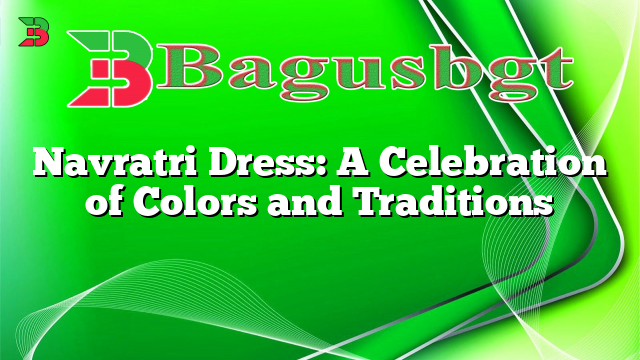Hello readers! As the festive season approaches, it’s time to gear up for the vibrant and joyous Navratri festival. Navratri, meaning “nine nights,” is a Hindu festival celebrated with great enthusiasm and devotion. It is a time to worship the divine feminine energy and indulge in traditional dances like Garba and Dandiya. One of the most important aspects of Navratri is the attire worn during these festivities. In this article, we will explore the world of Navratri dresses, their unique features, and the significance they hold.
1. The Essence of Navratri Dress
Navratri dress is more than just a garment; it represents the cultural heritage and folklore of the region. The dress typically consists of a chaniya choli for women and a kediyu or kurta for men. These outfits are rich in colors, embroidery, and mirror work, reflecting the vibrant spirit of the festival.
2. Colors of Navratri Dress
Each day of Navratri has a dedicated color, and people dress accordingly to honor the different forms of Goddess Durga. From serene whites to bold reds and vibrant yellows, Navratri dresses embrace a wide spectrum of colors. The choice of color holds symbolic meaning, with red representing vigor and yellow symbolizing joy and positivity.
3. Traditional Embroidery and Mirror Work
Navratri dresses are adorned with intricate embroidery and mirror work, which adds a touch of elegance and grace. The embroidery patterns are inspired by traditional motifs like flowers, peacocks, and geometric shapes. These embellishments not only enhance the beauty of the dress but also reflect the rich craftsmanship of the artisans.
4. Chaniya Choli: The Women’s Ensemble
The chaniya choli is the traditional attire for women during Navratri. It consists of a flared skirt called chaniya, a fitted blouse known as choli, and a dupatta. The chaniya is often embellished with vibrant prints, mirror work, and lace borders, while the choli complements it with intricate embroidery and back designs. The dupatta adds an extra layer of elegance and can be draped in various styles.
5. Kediyu: The Men’s Attire
Men typically wear a kediyu or kurta paired with dhoti or trousers during Navratri. The kediyu is a short, pleated jacket with intricate embroidery and mirror work. It is worn over a shirt and paired with dhoti or trousers. The ensemble is completed with a turban or a traditional headgear, enhancing the overall traditional appeal.
6. Comfort and Ease of Movement
Navratri dresses are not only visually appealing but also designed for comfort and ease of movement. The flared silhouette of the chaniya choli allows women to dance gracefully, while the lightweight fabric of the kediyu enables men to participate actively in the energetic Garba and Dandiya dances.
7. Availability and Variety
Navratri dresses are readily available both offline and online, catering to a wide range of preferences and budgets. From traditional stores to designer boutiques and e-commerce platforms, one can explore a plethora of options. Each region in India also has its unique style of Navratri dress, adding to the diversity and richness of choices.
8. Maintenance and Care
Navratri dresses, being rich in embroidery and mirror work, require special care and maintenance. It is advisable to dry clean them to preserve their beauty and prevent any damage. Storing them in a cool and dry place helps maintain their longevity, ensuring they can be cherished for years to come.
9. Alternative Navratri Dress Options
While the traditional chaniya choli and kediyu remain popular choices, there are alternative options for those seeking a modern twist. Indo-western fusion outfits, such as lehenga sarees and dhoti pants with crop tops, have gained popularity in recent years. These outfits blend traditional elements with contemporary designs, allowing individuals to express their personal style.
10. Navratri Dress: Celebrating Diversity
Navratri dress is not limited to a particular community or region. People from different backgrounds and cultures participate in the festivities, embracing the vibrant attire as a symbol of unity and diversity. It is a celebration of colors, traditions, and the spirit of togetherness.
Conclusion:
Navratri dress holds immense cultural and symbolic significance during the festive season. From the traditional chaniya choli and kediyu to modern fusion outfits, there is a wide range of choices available for everyone. These dresses not only reflect the rich heritage of India but also celebrate the spirit of joy, devotion, and unity. So, let’s embrace the colors and traditions of Navratri with our exquisite attire and dance to the beats of celebration!
| Category | Feature |
|---|---|
| Attire for Women | Chaniya Choli |
| Attire for Men | Kediyu or Kurta |
| Colors | Representational significance |
| Embroidery | Intricate patterns and mirror work |
| Comfort | Designed for ease of movement |
| Availability | Wide range of options |
| Maintenance | Dry cleaning and proper storage |
| Alternative Options | Indo-western fusion outfits |
| Symbolism | Celebration of diversity |
Frequently Asked Questions (FAQ)
Q: Can men wear chaniya choli during Navratri?
A: While chaniya choli is traditionally worn by women, men can opt for a kediyu or kurta with dhoti or trousers as their Navratri attire.
Q: Are Navratri dresses only worn during the festival?
A: Navratri dresses are primarily worn during the festival, but they can also be worn on other festive occasions and cultural events.
Q: Where can I buy Navratri dresses?
A: Navratri dresses are available in traditional stores, designer boutiques, and online platforms. You can explore a wide range of options in terms of design, budget, and region-specific styles.
Q: How do I maintain the embroidery and mirror work on Navratri dresses?
A: It is recommended to dry clean Navratri dresses to ensure the longevity of the embroidery and mirror work. Storing them in a cool and dry place also helps in preserving their beauty.
Q: Can I wear an Indo-western outfit for Navratri?
A: Yes, Indo-western fusion outfits like lehenga sarees and dhoti pants with crop tops are a popular alternative choice for Navratri. They blend traditional elements with modern designs, allowing you to create a unique style statement.
Q: Is there any specific significance behind the colors of Navratri dresses?
A: Each day of Navratri is associated with a specific color that represents a particular form of Goddess Durga. The colors hold symbolic meaning and are believed to invoke the blessings and qualities associated with each form.
Q: Can I wear Navratri dresses if I am not from the Indian culture?
A: Navratri is celebrated by people from various cultural backgrounds and communities. You can certainly participate in the festivities and wear Navratri dresses as a way to embrace the vibrant traditions and celebrate unity in diversity.
Q: Are there any specific accessories that complement Navratri dresses?
A: Yes, traditional accessories like oxidized jewelry, colorful bangles, and embellished footwear complement Navratri dresses beautifully. They add a touch of elegance and enhance the overall festive look.
Q: Can I customize my Navratri dress?
A: Yes, many designers and boutiques offer customization options for Navratri dresses. You can discuss your preferences and requirements with them to create a personalized outfit that reflects your style.
Q: Is it necessary to wear a specific type of footwear with Navratri dresses?
A: There are no specific rules regarding footwear for Navratri dresses. However, colorful and embellished footwear like mojdis and juttis are popular choices as they complement the vibrant and festive look of Navratri dresses.
Q: Can I wear Navratri dresses for other dance forms apart from Garba and Dandiya?
A: While Navratri dresses are traditionally worn for Garba and Dandiya dances, you can certainly wear them for other dance forms or cultural events. The colorful and lively attire adds to the overall celebratory vibe and allows you to fully immerse yourself in the festive spirit.
Q: Are Navratri dresses suitable for all body types?
A: Yes, Navratri dresses are designed to suit various body types. The flared silhouette of the chaniya choli and the comfortable fit of the kediyu or kurta make them versatile options that can be customized to enhance individual body shapes and sizes.
Q: Can children wear Navratri dresses?
A: Absolutely! Navratri is a festival that brings joy to people of all ages, including children. There are adorable and age-appropriate Navratri dresses available for kids, allowing them to join in the festivities and experience the cultural traditions.
Q: What is the significance of mirror work on Navratri dresses?
A: Mirror work is a prominent feature of Navratri dresses. The mirrors are believed to reflect evil spirits and protect the wearer from negative energies. Additionally, the shimmering effect of the mirrors adds to the overall visual appeal, making the dresses vibrant and eye-catching.
Q: Can I wear Navratri dresses for other festive occasions?
A: While Navratri dresses are primarily associated with the festival, they can also be worn for other festive occasions like weddings, engagements, and cultural events. Their colorful and ornate designs make them suitable for celebrating and embracing the joyous spirit of any festive gathering.
Conclusion:
Navratri dresses are not just garments; they are a celebration of culture, tradition, and unity. From the vibrant chaniya choli for women to the intricately embroidered kediyu for men, Navratri dresses embody the essence of the festival. With their rich colors, exquisite embroidery, and comfortable designs, these outfits allow people to immerse themselves in the festive spirit and celebrate the diversity of Indian traditions. So, let the colors of Navratri dress fill your wardrobe and dance to the rhythmic beats of joy and togetherness!






